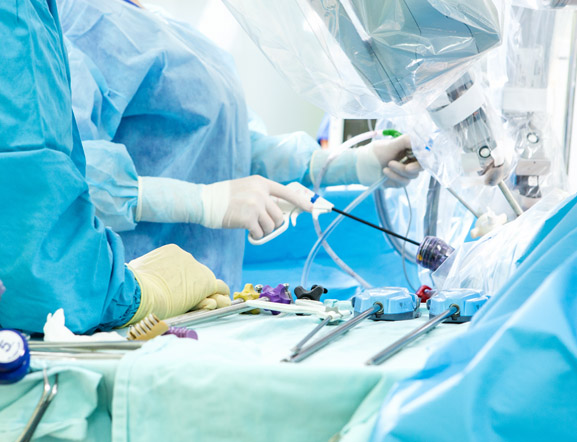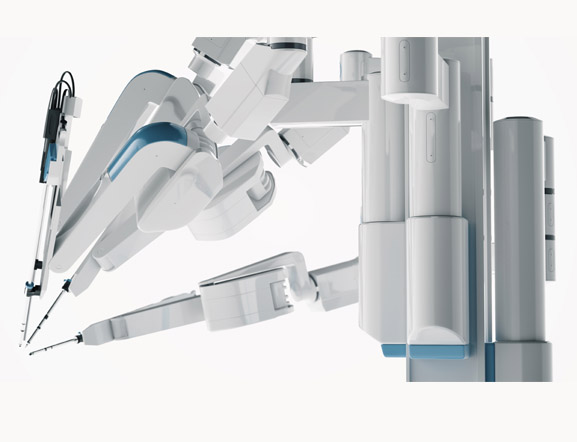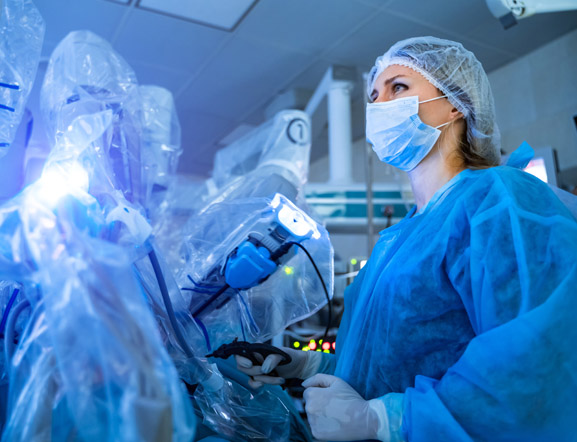Robotic assisted prostate cancer surgery
Your prostate is a walnut-sized gland that is part of the male reproductive system. This gland produces fluid that is part of the male reproductive system. Prostate cancer occurs when abnormal cells grow out of control in your prostate gland. Worldwide, more than 900 000 men are diagnosed with prostate cancer each year, making it the second most common cancer in men after lung cancer.
Regular screening, early detection and improved treatment allow more men to survive prostate cancer.
If the cancer is diagnosed early, when it is still localised or still contained in the gland, a five year survival rate is almost 100%.
Symptoms of prostate cancer vary but might include blood in your urine, waking up frequently at night to urinate, difficulty stating or stopping your urine flow, weak or interrupted urine flow, painful or burning urination, difficulty getting an erection, painful ejaculations, unexplained weight loss and/or frequent pain or stiffness in the lower back.
Prostate cancer can be detected using screening tests such as a digital rectal exam (DRE), a prostate specific antigen (PSA) test and a biopsy. During DRE, your doctor uses a gloved finger to test for hard or lumpy areas on your prostate gland. PSA is a simple blood test to identify signs of prostate cancer. IF you PSA level is high, or has increased compared to your previous test, your doctor may order a biopsy to see if the increase is due to cancer or another reason. During the biopsy, your doctor will use a thin needle to remove small tissue samples from your prostate. The samples will be assessed in a pathology laboratory for signs of cancer.
Treatments & Surgical Options
Treatment and surgical options for prostate cancer may include radiation, cryotherapy, watchful waiting, hormone therapy or prostatectomy.
Radiation and cryotherapy work by radiating, burning or freezing the prostate.
With watchful waiting (also known as active surveillance), your doctor will monitor the prostate with regular tests and check-ups.

Oral and laparoscopic surgery
Surgery to remove the cancerous prostate is known as a prostatectomy. Prostate cancer surgery can be performed by means of either open surgery or minimally invasive surgery (laparoscopy).
Open surgery requires the surgeon to make a large abdominal incision to fit his or her hands and instruments inside your body. Open surgery allows the surgeon to see and touch your organs during the operation. With laparoscopic surgery, he surgeon operates through a few small incisions using long-handled instruments and a tiny camera. The camera sends images back to a video monitor in the operating theatre to guide the surgeon as he or she operates.

Robotic assisted da Vinci surgery
This is a minimally invasive surgical option, id your doctor recommends prostate cancer surgery you may be a candidate for da Vinci surgery. Though it is often called “robotic’ surgery, the da Vinci technology cannot act on its own but the cutting edge technology assists the surgeon to perform intricate and complex procedures more accurately.
Using the da Vinci system, your surgeon makes a few small incisions – similar to traditional laparoscopy. The da Vinci system provides the surgeon with magnified three-dimensional (3D) high-definition (HD) vision. Your surgeon controls the da Vinci system from a console which translates his or her hand movements into smaller, more precise movements of tiny instruments inside your body. These tiny instruments are able to rotate much more than the human wrist, which, together with the superior vision offered by the system, enable your surgeon to operate with enhanced precision, dexterity and control. The da Vinci system has been used successfully worldwide in approximately 1.5 million various surgical procedures to date.
Benefits of Robotic Assisted Prostatectomy
As a result of the da Vinci technology, robotic assisted prostatectomy performed at Netcare hospitals offers the following potential benefits over open and laparoscopic surgery, including:
- · More precise removal of cancerous tissue
- · Shorter hospital stay
- · Less blood loss and less need for need for a transfusion
- · Fewer days with catheter
- · Reduced pain after surgery
- · Less risk of infection and other complications
- · Less blood loss and need for blood transfusion
- · Less scarring
- · Faster recovery
- · Less risk of erectile dysfunction and incontinence

Risks and considerations related to prostatectomy
All surgery presents risk and serious complications may occur in any surgery. Examples of serious and life threatening complication include injury to tissues or organs, bleeding, infection and internal scarring that that may cause long-lasting dysfunction or pain. Temporary pain or nerve injury has been linked to the inverted position often used during abdominal and pelvic surgery.
Potential risks of any prostatectomy procedure and da Vinci surgery include the following:
- · Urinary and sexual dysfunction due to nerve damage
- · Rectal or bowel injury
- · Blocked artery in the lung
- · Blocked bowel
- · Surrounding nerve damage
- · Hernia or bulging at the incision site

